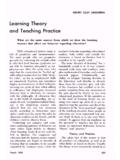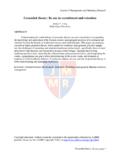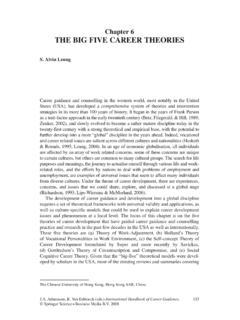Transcription of The Review of Economic Studies Ltd. - Weebly
1 The Review of Economic Studies Ltd. A theory of the Business Cycle Author(s): Michal Kalecki Source: The Review of Economic Studies , Vol. 4, No. 2 (Feb., 1937), pp. 77-97. Published by: The Review of Economic Studies Ltd. Stable URL: Accessed: 12/11/2010 11:56. Your use of the JSTOR archive indicates your acceptance of JSTOR's Terms and Conditions of Use, available at JSTOR's Terms and Conditions of Use provides, in part, that unless you have obtained prior permission, you may not download an entire issue of a journal or multiple copies of articles, and you may use content in the JSTOR archive only for your personal, non-commercial use. Please contact the publisher regarding any further use of this work. Publisher contact information may be obtained at Each copy of any part of a JSTOR transmission must contain the same copyright notice that appears on the screen or printed page of such transmission.
2 JSTOR is a not-for-profit service that helps scholars, researchers, and students discover, use, and build upon a wide range of content in a trusted digital archive. We use information technology and tools to increase productivity and facilitate new forms of scholarship. For more information about JSTOR, please contact The Review of Economic Studies Ltd. is collaborating with JSTOR to digitize, preserve and extend access to The Review of Economic Studies . A theory of the Business Cycle INTRODUCTION. I. THIS paper, in which I attempt to give an analysis of investment processes,is closely allied to the Keynesian theory . The latter can be divided into two parts: (I) the determination of short-period equilibrium with a given capital equipment and with a given rate of investment; (2) the deter- minationof the rate of investment.
3 In the section " Short-periodEquilibrium". I give a representationof the first part of the Keynesian theory , arriving at its chief theoremsin a slightly differentway. In the followingthree sections I. deal with the determinationof the rate of investment and there the results are fundamentallydifferentfromthose of the Keynesiantheory. These divergences are due to the importantrole played in my argumentsby the time-lag between investment decisions and investment production, and also to a different treatment of the question of the inducement to invest. In the last section I. show that the investment processesnecessarilycreate a business cycle. 2. I assumein the whole paper that the workersdo not save (or dis-save). For the savings of workers certainly do not play an important part in the Economic process, while to take it into considerationcan often obscure some essential features of the capitalist economy.
4 Therefore, it seems to me preferableto deal here with a system in which only capitalists (entrepreneurs and rentiers) save-exactly as is usually admitted in the assumptionof a closed economy as being justifiablein a first approach. (I assume, also, in the whole paper a closed economicsystem.). The second simplifying assumption I make concerns the wear and tear of fixed capital caused by its use in production. I assume that this " extra wear and tears" is negligible and thus the total wear and tear is due to obsolescence. This assumption,contrary to the Keynesian conception of user- cost, does not imply an underestimationof its importancebut is simply made to avoid complicationsinherent in this subject. I think, however, that this simplificationwill not affect the results of our analysis much. With this assumption, the only prime costs are those of labour and raw materials.
5 If we thus denote by the income of capitalists from an enterprise the difference between the value of its output and the value of prime costs, we find that this income is equal to the value of productionminus the cost of labour and raw materials. We shall call the national income the sum of capitalists' and workers'incomes. It is easy to see that the national income is equal to the sum of the value of the output of all enterprisesminus the value of the output of raw materials. But, hence, it follows that the national income is equal to the value of consumption, purchases of fixed capital equipment, and increase of stocks. The value of the purchases of fixed capital and the increaseof stocks we shall call investment. It is clear that this is gross invest- ment and also that the income of capitalists means here their gross income, that from either the supplementarycost is not subtracted.
6 For both Keynes' theory and this paper the notion of a given capital 77. 78 THE Review OF ECONOMICSTUDIES. equipmentis essential. The objectionis often raisedthat it is wrongto assume a given capital equipment within a period, because the investment changes the equipmentduringthis perod. The answeris very simple: this periodcan be made so short that the change in the equipment is small enough not to affect the formation of output and income. For output and income are quantitiesmeasuredper unit of time and thus are not dependenton the length of the period taken into consideration,whilst the change of equipment is, caeterisparibus,proportionateto this length. SHORT-PERIOD EQUILIBRIUM. i. Output with a given capital equipment depends on the quantity of labour employed and on its distribution among the various sections of this equipment.
7 In every enterprise the employment is pushed to the point at which marginalrevenueis equal to the marginalprime cost. We shall representthe point of intersectionof the marginalrevenue and the marginalprime cost curves as follows. XVesubtract from both price and primecosts the cost of raw materials,and thus we obtain so-calledvalue added and labourcosts respectively. We can now say that the output of an enterprise is given by the intersectionof the curves of marginalvalue added and of mar- ginal labour-cost (see Fig. i). Marginalvalue added and marginallabour-cost are both expressed here in wage units.' We shall call short-timeequilibrium a state in which the marginal labour-cost curves and marginal value-added curves do not move. With a given capital equipment the curves of marginal labour-costare fixed. The establishmentof short-timeequilibriumwith a given equipment will thus consist in the shift of marginal value-addedcurves.
8 The area OABC is the value added of the enter- prise expressed in wage-units, the hatched area is the income of the capitalists obtained from this enterprise, while the unhatched area is the income of the workers. Thus the sum of OABC-areas of all enterprises--is the national income expressed in wage-units, while the sum of the hatched areas is the total income of the capitalists, and that of the unhatched areas the total income of the workers. The national income is also equal to the value of total consumptionand total investment and, as we I have assumedthat the workersdo not save, the sum of the unhatched areas covers the value of the con- FIlG,.,. sumption of the workers, while the sum of the I Keynes defines the wage-unit as follows: " .. in so far as different grades and kinds of labour and salaried assistance enjoy a more or less fixed relative remuneration, the quantity of employment can be sufficiently defined for our purpose by taking an hour's employment of ordinary labour as our unit and weighting an hour's employment of special labour in proportion to its remuneration; an hour of special labour remunerated at double ordinary rates will count as two units.
9 We shall call the unit in which the quantity of emplovment is measured the labour-unit; and the money-wage of a labour-unit we shall call the wage-unit." The General theory of Employment, Interest and Money, p. 41. A theory OF THE BUSINESS CYCLE 79. hatched areas is the value of the consumption of the capitalists and of the investment. We can now make clear the key position of the spendingof the capitalists in the formationof short-timeequilibrium. In such an equilibriumthe marginal value-added curves remain by definition in a certain determined position. As we have just shown, the sum of the hatched areasis equal to the spendingof the capitalists on consumptionand investment, and the sum of the unhatched areas covers the consumption of the workers. There can be no spontaneous change in the spendingof the workers,because they spend, by assumption,as much as they earn, but such changes of spendingare quite possible for capital- ists.
10 ' Let us assume that the capitalists spend a given amount more than before per unit of time. Then there will be a slhiftin the marginalvalue-addedcurves until the sum of the hatched areas is equal to the increased spending by the capitalists for consumptionand investment. As the sum of the hatched areas is also equal to the total income of the capitalists, the increaseof their spending "forces " their income to rise by the same amount. It is clear that in the new short-periodequilibriumthe employment, the incomeof the workers,and thereforethe value of their consumption (measured in wage units), is greater than before. Hence, it follows that the demand for all kinds of investment and consumption-goods, for both capitalists and workers,has risen, and thus a shift of the marginal value-added curves must have taken place in all industries.








